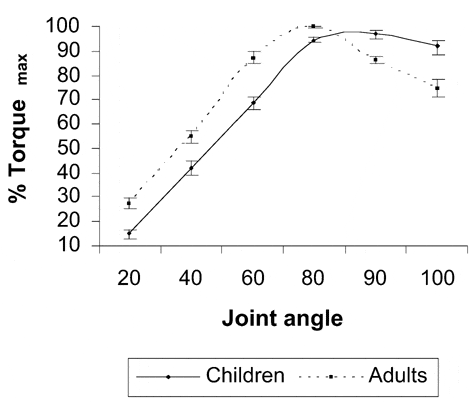Changes in torque, as a result of changes in muscle length, are well documented in adults (Rassier et al. 1999). However, research on this phenomenon in children is limited. Marginson & Eston (2001) observed differences in the torque-joint angle relationship in boys and men. We attributed this to differences in passive muscle stiffness, which is correlated with flexibility (Gleim & McHugh, 1997). Flexibility tends to decrease with age (Alter, 1996). The purpose of this study was to compare both range of motion of the hip and torque-joint angle characteristics of the quadriceps in boys and men.
Ten men (mean ± S.D., age 22.2 ± 2.7 years) and ten boys (age 9.9 ± 0.32 years), performed two 3 s, maximal voluntary isometric contractions of the quadriceps, at six different joint angles (20, 40, 60, 80, 90 and 100 deg (0 deg = full extension)), on an isokinetic dynamometer. Contractions were performed consecutively at each angle. A 5 min break separated the first and second set of contractions and a 3 min break separated each contraction. Torque data were expressed as a percentage of maximal torque (%torquemax). Passive hip extension was assessed in the prone position, with the knee flexed and splinted at 120 deg. All participants (and parents) gave written informed consent to participate in this study, which received local ethics approval. Data were analysed by two-factor, group (2) X joint angle (6) ANOVAs.
Boys had significantly higher hip flexion (38 ± 4.9 cf. 24 ± 8.5 deg (t2,18 = 4.5, P < 0.01)). The %torquemax increased significantly at 20, 40, 60 and 80 deg of knee flexion in both groups (F2.7,51.6 = 23.3, P < 0.01)GG. For men, %torquemax decreased significantly at 90 and 100 deg, whereas there was no difference at these angles in boys. The %torquemax values at 20, 40 and 60 deg were higher in men compared with boys. There was no group difference in %torquemax at 80 deg. However, %torquemax values were higher at 90 and 100 deg for boys.
These findings support earlier observations by Marginson & Eston (2001) and suggest that age and muscle stiffness are moderating factors in the torque-joint angle relationship.

